Cost of maternity care to public hospitals: a first 1000-days perspective from Queensland
Emily J. Callander A E , Jennifer Fenwick B C , Roslyn Donnellan-Fernandez B , Jocelyn Toohill B D , Debra K. Creedy B , Jenny Gamble B , Haylee Fox A and David Ellwood AA School of Medicine, Griffith University, Southport, Qld 4215, Australia. Email: haylee.fox@jcu.edu.au; d.ellwood@griffith.edu.au
B School of Nursing and Midwifery, Griffith University, Meadowbrook, Qld 4131, Australia. Email: r.donnellan-fernandez@griffith.edu.au; d.creedy@griffith.edu.au; j.gamble@griffith.edu.au
C Gold Coast University Hospital, Southport, Qld 4215, Australia. Email: j.fenwick@griffith.edu.au
D Office of the Chief Nurse and Midwifery Officer, Queensland Health, Herston, Qld 4006, Australia. Email: j.toohill@griffith.edu.au
E Corresponding author. Email: e.callander@griffith.edu.au
Australian Health Review 43(5) 556-564 https://doi.org/10.1071/AH18209
Submitted: 10 October 2018 Accepted: 7 March 2019 Published: 15 July 2019
Journal Compilation © AHHA 2019 Open Access CC BY-NC-ND
Abstract
Objective This study sought to compare costs for women giving birth in different public hospital services across Queensland and their babies.
Methods A whole-of-population linked administrative dataset was used containing all health service use in a public hospital in Queensland for women who gave birth between 1 July 2012 and 30 June 2015 and their babies. Generalised linear models were used to compare costs over the first 1000 days between hospital and health services.
Results The mean unadjusted cost for each woman and her baby (n = 134 910) was A$17406 in the first 1000 days. After adjusting for clinical and demographic factors and birth type, women and their babies who birthed in the Cairns Hospital and Health Service (HHS) had costs 19% lower than those who birthed in Gold Coast HHS (95% confidence interval (CI) –32%, –4%); women and their babies who birthed at the Mater public hospitals had costs 28% higher than those who birthed at Gold Coast HHS (95% CI 8, 51).
Conclusions There was considerable variation in costs between hospital and health services in Queensland for the costs of delivering maternity care. Cost needs to be considered as an important additional element of monitoring programs.
What is known about the topic? The Australian maternal care system delivers high-quality, safe care to Australian mothers. However, this comes at a considerable financial cost to the Australian public health system. It is known that there are variations in the cost of care depending upon the model of care a woman receives, and the type of delivery she has, with higher-cost treatment not necessarily being safer or producing better outcomes.
What does this paper add? This paper compares the cost of delivering a full cycle of maternity care to a woman at different HHSs across Queensland. It demonstrates that there is considerable variation in cost across HHSs, even after adjusting for clinical and demographic factors.
What are the implications for practitioners? Reporting of cost should be an ongoing part of performance monitoring in public hospital maternity care alongside clinical outcomes to ensure the sustainability of the high-quality maternal health care Australian public hospitals deliver.
Additional keywords: data linkage, efficiency, maternity services, performance monitoring, perinatal care, postpartum, pregnancy.
Introduction
Maternity services in Australia rank highly against other Organisation for Economic Cooperation and Development (OECD) countries for maternal and neonatal safety.1 As such, contemporary attention is being given to refining the delivery of care. This includes improving the experience and woman-centred outcomes of childbearing women2 and lowering Australia’s relatively high rates (vs other high-income countries) of routine or unnecessary obstetric interventions, many of which are not supported by best available evidence.3 Focus is also being given to optimising the delivery of maternity services, which includes enabling midwives to work to their full scope of practice and delivering services in the most efficient manner.4 There is still considerable variation in intervention rates and the models of care that are delivered between institutions. This variation may have important implications for each hospital’s or service’s costs of delivering maternity services because obstetric intervention is known to result in higher costs,5 and the existing literature has identified that costs vary based upon the models of care received by women.6,7 Despite this potential for variation in costs, there is a lack of consideration of cost and efficiency in routine performance monitoring of maternity services in Australia.
At the national level, performance monitoring in maternity care is largely centred around the National Core Maternity Indicators (NCMI),8 with other discrete performance monitoring programs implemented at the state and territory level.9,10 These monitoring programs are designed to capture the change in the safety and quality of services. However, the omission of cost and efficiency domains does not allow for the transparent and routine assessment of the value of current maternity services, nor any documentation of efficiency improvements that are made over time. Cost monitoring is important because Australia ranks among the highest in high-income countries for the cost of discrete events, on par with the US.3 For Australian public maternity services to continue to deliver world-class care, they must also be efficient providers of care to ensure sustainability in tight fiscal environments.
The Independent Hospital Pricing Authority (IHPA) publishes annual comparisons of the costs of maternity-related Australian Refined Diagnostic Related Groups (AR-DRGs) as a part of its costing exercise,11 but these are only produced at the state or territory level and are only at the activity level, as classified by the AR-DRG classification system (https://www.accd.net.au/Downloads.aspx#ArDrgV9Descriptions, accessed 1 October 2018), and so do not account for the costs of the whole journey of maternity care. Women’s Healthcare Australasia (WHA) also undertakes a benchmarking program to compare the costs of providing maternity services between participating institutions.12 However, the focus of WHA reporting is also at the ‘activity’ level. Furthermore, information produced by WHA is not released publicly, and therefore it is not available for transparent and routine performance monitoring.
Because public hospitals are currently funded based on activities, it is not surprising that in the few instances where cost is reported it is at the activity level. Yet, nomenclature regarding the provision of health care, in general, has evolved beyond the conceptualisation of discrete occasions of service towards patient-centred care.13 Within maternity care, the notion of woman-centred care is also increasing in conventionality.14 Woman-centred care places the woman, and her complete healthcare journey, at the centre of maternity services. To align reporting with contemporary maternity best practice, performance measurement should move away from the focus on single-service episodes to the transparent and routine reporting of costs for the woman’s entire transition to motherhood.
The aim of the present study was to identify the total costs associated with care delivered in public hospitals over the ‘first 1000 days’15 for all women giving birth in different hospital and health services (HHS) across Queensland in a defined time period and their babies. By taking this approach we captured the woman’s full maternity healthcare journey in the public hospital system, which allowed us to compare costs across different public HHSs. The study also aimed to determine whether there was a change in the cost of delivering care over time.
Methods
For this project we used a dataset called Maternity1000.16 This is a whole-of-population linked administrative dataset, which is being continuously updated over time by the research team. Maternity1000 uses the Queensland Perinatal Data Collection to identify all women who gave birth in Queensland within a defined time period, plus their resulting children. The records of mothers and children were then linked to the Admitted Patient Data Collection, Emergency Department Information System and Clinical Costing Unit data. The dataset also linked Medicare Benefits Schedule and Pharmaceutical Benefits Scheme claims records, but these were not included in the present study because this analysis was concerned with quantifying costs incurred in the public hospital system only. The first data extraction contains data for all women (and their children) who gave birth in Queensland between 1 July 2012 and 30 June 2015.
This study included data relating to all in-patient and emergency department health service use in a public hospital for women throughout their pregnancy, and for women and the babies from birth through to 24 months after birth to broadly align with the ‘first 1000 days’.15 Costs related to each public hospital admission were extracted from the Queensland Health Clinical Costing Unit. Costs were adjusted to 2017–18 Australian dollars based on the Consumer Price Index.17 Data from the Clinical Costing Unit were not available for emergency department presentations. As such, costs related to each presentation were assigned from the Urgency Related Group (URG) code listed for each event on the Emergency Department Information System, and the corresponding cost from the National Hospital Cost Data Collection (NHCDC) produced by the IHPA.11 We used the NHCDC round corresponding to the time the emergency department service was accessed.
Women and their babies were grouped according to the HHS that the hospital they birthed in belonged to. The HHS was chosen as the grouping variable rather than the hospital of birth to limit the number of units of comparison, as well as because of the low birthing numbers in some small hospitals. All costs were attributed back to the HHS of birth, because this paper takes the perspective that care and events at the time of birth potentially have long-term effects on health outcomes, and thus health costs. Mater public hospitals in Brisbane were classified separately.
Analysis
The initial analysis was undertaken to identify the public hospital costs for all women and their babies. The initial descriptive statistics reported aggregated costs for mother and baby combined, as well as disaggregated costs for mothers and babies separately. A linear model of the log of the total cost for both mother and baby over the ‘first 1000 days’ time period was then constructed, to account for the skewed distribution of the cost data. After comparing actual and predicted values, a linear model with a log-transformation was chosen as the best fit for the data. Generalised linear models with varying distributions and link functions were also tested. The variables included in the model were those deemed to clinically influence health service use. Each was initially tested in univariate models. The independent variables included in the model were as follows: mother’s age, mother’s age squared (included as a quadratic term because age was not linearly related to costs), vertex presentation, first pregnancy, gestation (weeks) at birth, baby’s birthweight, pre-existing health conditions that were deemed to affect the pregnancy, complications that developed in pregnancy, mother identifying as Indigenous, smoking before 20 weeks, body mass index (BMI), area-based income deprivation decile (classified by the Index of Relative Socio-economic Disadvantage (IRSD) decile18), rurality of the woman’s usual place of residence at the time of birth (classified by Accessibility and Remoteness Index of Australia (ARIA) code), the mother having two births within the study time period, the mother having three births within the study time period and the infant’s year of birth. These variables are consistent with those used in other casemix adjustment studies for maternity care.19 In order to account for the effects of birth interventions on cost, we repeated the analysis with birth intervention (Caesarean section, vaginal birth with forceps or vacuum, vaginal birth with no intervention) added to the model.
All analyses were undertaken in SAS 9.4 (SAS Institute, Cary, NC, USA). Ethics approval was obtained from the Townsville Hospital and Health Service Human Research Ethics Committee (HREC; HREC/16/QTHS/223) and the Australian Institute of Health and Welfare HREC (EO2017-1-338). In addition, we obtained Public Health Act approval (RD007377) for the study.
Results
There were 134 910 births in public hospitals in Queensland between 1 July 2012 and 30 June 2015. The mean unadjusted cost of health services accessed in a public hospital was A$9606 for each mother in the first 1000 days. This mostly consisted of in-patient costs, which averaged A$8795 (compared with a mean cost for emergency department services of A$771). The bulk of this cost occurred during pregnancy and birth, with smaller (and similar) amounts in the first and second years after birth (Table 1). The mean unadjusted cost for each baby was A$7910 in the first 1000 days. Combined, the average cost of health service use for the mother and the baby in the first 1000 days was A$17 406.
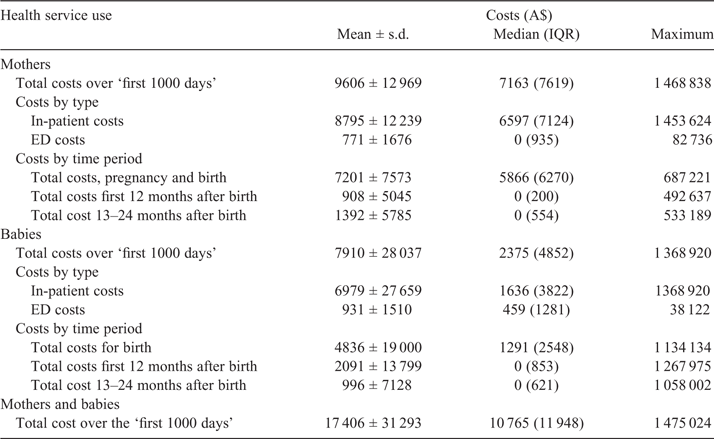
|
Table 2 shows the adjusted mean total cost for the health service use of mothers and babies attributable to each HHS. The results of the model used to produce the results are given in Appendix 1.
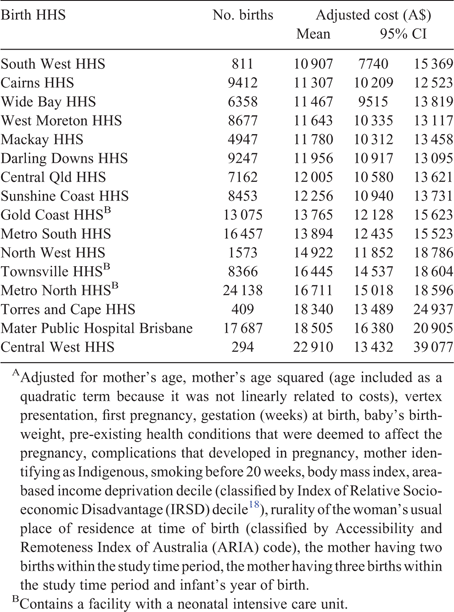
|
After adjusting for the clinical and demographic factors included in the model, women and their babies birthing at South West HHS (A$10 9907), Cairns HHS (A$11 9307) and Wide Bay HHS (A$11 9467) had the lowest mean costs in public hospitals for the first 1000 days. Women and their babies birthing at Central West HHS (A$22 9910), Mater Public Hospital Brisbane (A$18 9505) and Torres and Cape HHS (A$18 9340) had the highest average costs in public hospitals for the first 1000 days.
Figure 1 shows the differences in the birth event rates by facility. The rate of vaginal births without instruments was highest in the Torres and Cape (82%), Central West (69%), West Moreton (68%) and Central Qld (68%) HHSs, and lowest in Metro North HHS (56%), Mater Public Hospital Brisbane (57%), and Cairns, Metro South, South West and Townsville HHS (62%). The rate of instrumental vaginal births was highest in Mater Public Hospital Brisbane (15%), and the rate of Caesarean sections was highest in Metro North HHS (33%).
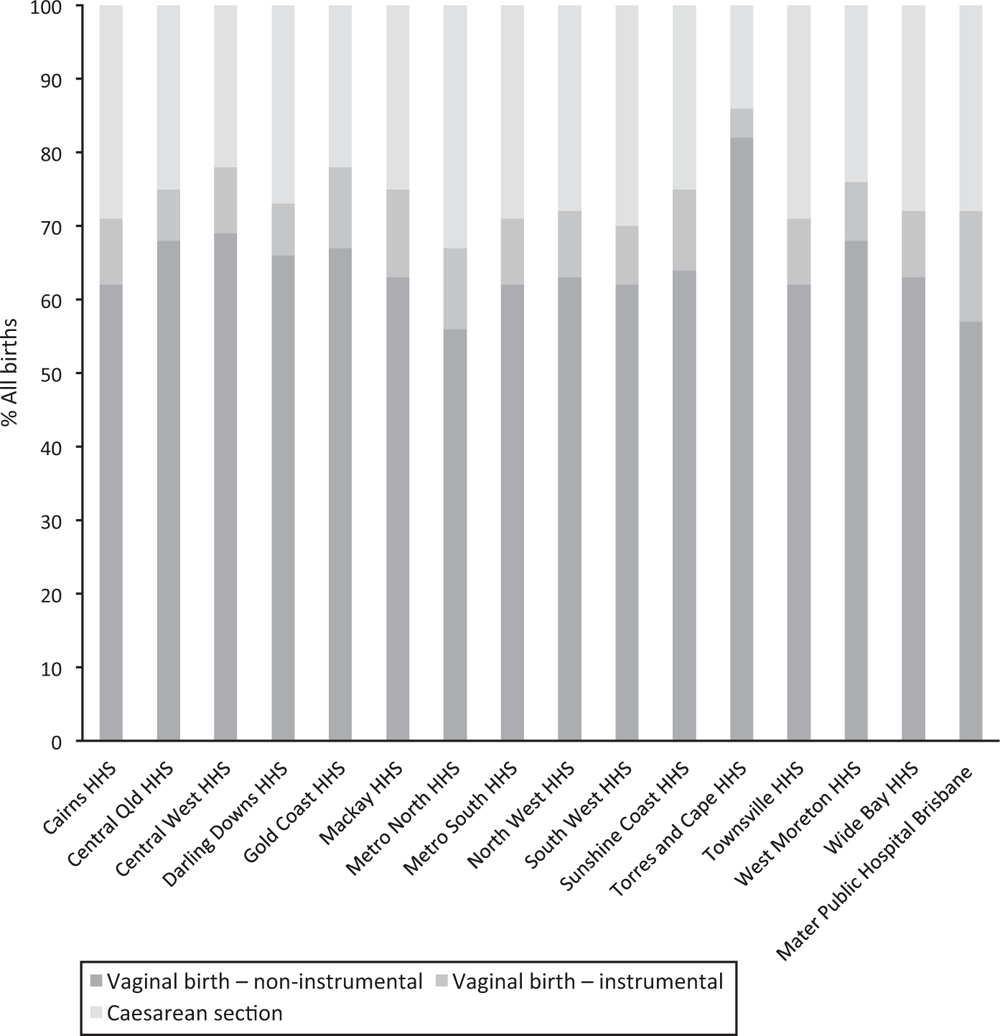
|
The adjusted mean total cost for health service use by mothers and babies attributable to each HHS with type of birth added to the model is given in Table 3, with the results of the model used to produce the results given in Table 4. Although the position of the facilities altered in terms of lowest to highest costs, costs still ranged from A$12 9046 in Cairns HHS to A$23 9312 in Central West HHS.
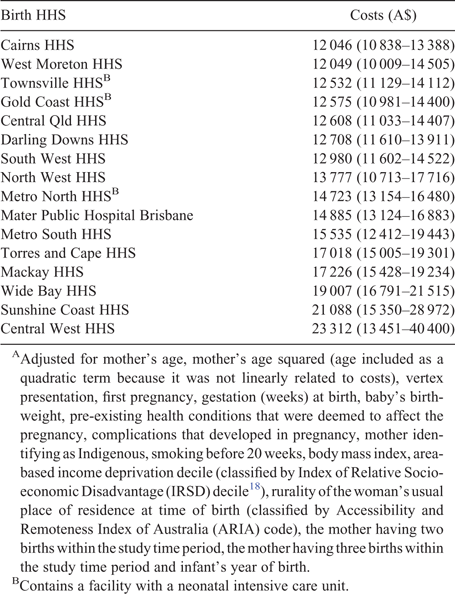
|
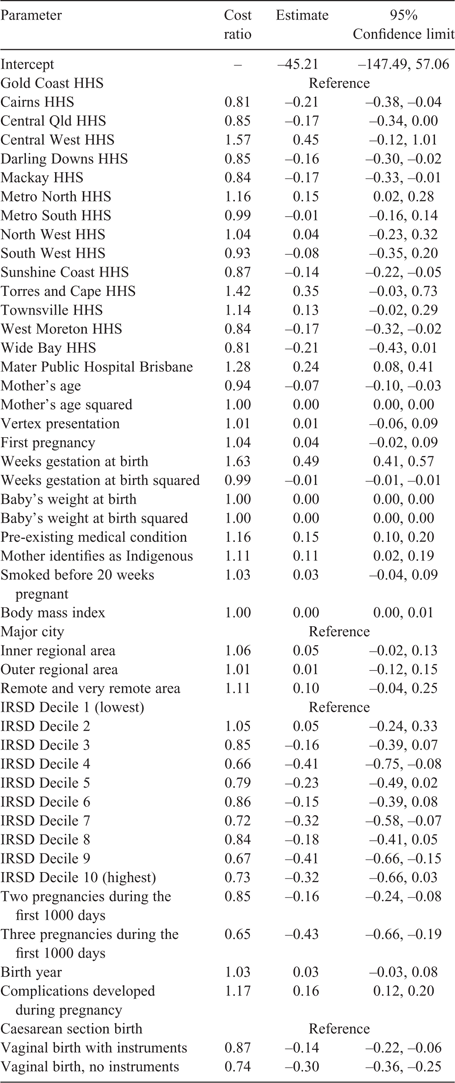
|
Costs decreased with a woman’s age until after 33 years of age, when costs increased. Costs also increased with a rising BMI. Mother’s identifying as Indigenous had higher costs (11%; 95% confidence interval (CI) 2, 19) than mothers not identifying as Indigenous, as did those with pre-existing health conditions (16%; 95% CI 10, 20). Vaginal births with no instruments were 26% less costly (95% CI –31%, –23%) than Caesarean section births.
Discussion
The intention of this study was to identify the total costs to the public hospital system associated with the ‘first 1000 days’ for all women giving birth and their babies in different public hospital jurisdictions across Queensland. In addition the study aimed to determine whether there was a change in cost over time. Taking this approach is an Australian first, because quantifying costs associated with maternity care at the individual level and within specific regions has not been done previously.
The results clearly identified considerable variation in costs depending on where women gave birth, but there did not appear to be evidence of costs changing over time. On average, the total cost per woman and baby was A$17 406. Women and their babies who gave birth within the HHSs of Cairns, West Moreton, Townsville, Gold Coast and Central Qld had the lowest costs, after adjusting for clinical and demographic factors, including birth type. The HHSs included in the analysis are of varying characteristics, reflective of the diverse demographics and geography of Queensland. Some, such as Torres and Cape HHS and Central West HHS, cover mostly rural areas and populations, which may contribute to higher costs of delivering care. Similarly, some metropolitan HHSs, particularly Metro North HHS, may receive clinically complex referrals, which may increase their mean costs. As such, this analysis adjusted all results by the clinical characteristics of women at each HHS as a means to control for this heterogeneity. Even after controlling for clinical and demographic factors, the costs in the HHS with the highest costs were 94% higher than those in the HHS with the lowest costs. The considerable variation, even after adjusting for clinical and demographic characteristics of the women and type of birth, indicates a potential variation in efficiency between health services offering maternity care that warrants further research with the inclusion of outcomes alongside cost.
There is sparse evidence within Australia of the cost-effectiveness associated with different maternity services. The seminal work7,20–22 that does exist has focused on assessing the cost-effectiveness of caseload midwifery, a model of care whereby the woman has access to continuity of care by a known or named midwife across pregnancy, labour and birth and the early transition to motherhood (commonly postpartum care for 6 weeks). Midwifery-led models such as caseload midwifery have been demonstrated to produce numerous benefits compared with medical care or standard care, with no identified increases in risk.23 Within Australia, evidence suggests that this model of care also reduces costs.7,20–22,24,25 However, these studies have been conducted primarily in populations of women deemed low risk and living in urban areas. The present study demonstrates that those considered low risk are also low cost. This study confirmed that older women, those with a high BMI, multiple pregnancies, pre-existing health conditions and pregnancy complications incur higher costs. This is important because we currently lack evidence for the cost-effectiveness of different models of care for women of high risk,26 who are high cost. Over half the mothers in Australia are now overweight or obese at their first antenatal visit, increasing morbidity and mortality for both mother and baby.27,28 It seems that this is a serious gap in the literature that should be seen as a research priority to ensure the sustainability of maternity services into the future.
The results also demonstrated the considerable variation in costs by type of birth, with vaginal births without intervention costing 26% less than Caesarean section births. It is known at the activity level that giving birth via Caesarean section is much more costly than a spontaneous vaginal birth due to the additional resources involved at the time of delivery,11,29 and the present study demonstrated that cost also appears to be higher over the longer term. It has been noted previously that although Australia has low rates of maternal and neonatal death1 (the most extreme adverse outcome), there is a considerable improvement to be made in other areas, particularly in reducing rates of unnecessary Caesarean sections, induction and episiotomy.2,30 This issue is not confined to Australia, with a Lancet series recently noting high rates of Caesarean section and Caesarean section overuse as an international concern.31 Australia’s high Caesarean section rates are not only detrimental to both the short- and long-term health outcomes of women and their newborns,32–34 but are also potentially detrimental to health system budgets given their high cost relative to vaginal birth demonstrated in the present study.
Given the high level of government investment in maternity care (around A$3 billion spent in 2013–14),35 monitoring costs to ensure efficiency should be an essential part of performance monitoring, alongside the measurement of quality, safety and outcomes for women and their babies.2 Although the present study is the first to report on the cost associated with maternity care at the individual level within Australia, outcome measures are also required to measure efficiency or productivity. The NCMI8 do go some way towards measuring quality and safety outcomes associated with maternity care, but Australia lacks the ability to routinely measure woman-centred outcomes for mothers and babies that are produced in maternity care. Measures from the NCMI do not reflect the actual maternal or infant outcomes that are produced, aside from stillbirth, maternal and neonatal death. Capturing such outcomes (e.g. maternal health-related quality of life and early childhood development scores) directly through standardised sets of outcomes such as the International Consortium for Health Outcomes Measurement’s (ICHOM) standard set for Pregnancy and Childbirth36 would allow public reporting of productivity and efficiency, and the outcomes to women and their babies that are being produced with the public investment. ICHOM items and standardised measures for pregnancy and childbirth reflect a primary health approach, capturing women’s physical, mental and social health outcomes. By defining global standard sets of outcome measures and driving their reporting worldwide, ICHOM aims to assist healthcare policy makers and funders to make value-for-money decisions about services.
A strength of this study is the fact that the results are based upon a whole-of-population linked administrative dataset. Being based on a census as opposed to a sample ensured that minority groups were not excluded due to sampling bias. Furthermore, we were able to include data from throughout the pregnancy to 2 years postpartum, thus capturing a significant proportion of the maternity care journey. Another strength of the study is the individual level of the dataset. This facilitated microlevel analysis as opposed to relying on averages to produce results for individual birthing locations or maternity services. However, a key weakness of the study was the omission of HHS out-patient data. This was due to the incompleteness of the Queensland Hospital Outpatient Data Collection for the years of interest. As the Maternity1000 dataset is updated over time, it is anticipated that out-patient data will become available for linkage. This will enable future studies on this topic.
Conclusion
Australia has a high-quality and safe maternal care system. However, in a tight fiscal environment with rapidly escalating health expenditure,37 all areas of healthcare services must strive for efficiency. This will require the reporting of the costs of delivering care alongside the outcomes that are produced. This study has shown that there is considerable variation across Queensland in the costs associated with health care delivered in public hospitals associated with the first 1000 days of the maternity journey depending on birth location. Further effort should be given to the identification of cost-effective models of care, particularly among women deemed at high risk of complications. Greater attention should also be directed to the identification of productivity and efficiency within maternity care, in addition to ongoing performance reporting of cost.
Competing interests
The authors declare no competing interests.
Acknowledgements
Funding for the creation of the Maternity1000 dataset was gratefully received from the Australian Institute of Tropical Health and Medicine, Stillbirth CRE and the Griffith School of Nursing and Midwifery. E. J. Callander receives salary support under an Australian National Health and Medical Research Council Career Development Fellowship (APP1159536).
References
[1] Organisation for Economic Cooperation and Development (OECD). OECD health statistics 2018. Paris: OECD; 2018.[2] Bryant R. Improving maternity services in Australia: the report of the Maternity Services Review. Canberra: Office of the Commonwealth Chief Nurse and Midwifery Officer; 2009.
[3] Shaw D, Guise J-M, Shah N, Gemzell-Danielsson K, Joseph KS, Levy B, Wong F, Woodd S, Main EK. Drivers of maternity care in high-income countries: can health systems support woman-centred care? Lancet 2016; 388 2282–95.
| Drivers of maternity care in high-income countries: can health systems support woman-centred care?Crossref | GoogleScholarGoogle Scholar | 27642026PubMed |
[4] Australian Health Ministers’ Advisory Council. National framework for maternity services consultation draft. Canberra: COAG Health Council; 2017.
[5] Tracy SK, Tracy MB. Costing the cascade: estimating the cost of increased obstetric intervention in childbirth using population data. BJOG 2003; 110 717–24.
| Costing the cascade: estimating the cost of increased obstetric intervention in childbirth using population data.Crossref | GoogleScholarGoogle Scholar | 12892682PubMed |
[6] Tracy SK, Welsh A, Hall B, Hartz D, Lainchbury A, Bisits A, White J, Tracy MB. Caseload midwifery compared to standard or private obstetric care for first time mothers in a public teaching hospital in Australia. BMC Pregnancy Childbirth 2014; 14 46
| Caseload midwifery compared to standard or private obstetric care for first time mothers in a public teaching hospital in Australia.Crossref | GoogleScholarGoogle Scholar | 24456576PubMed |
[7] Toohill J, Turkstra E, Gamble J, Scuffham PA. A non-randomised trial investigating the cost-effectiveness of midwifery group practice compared with standard maternity care arrangements in one Australian hospital. Midwifery 2012; 28 e874–9.
| A non-randomised trial investigating the cost-effectiveness of midwifery group practice compared with standard maternity care arrangements in one Australian hospital.Crossref | GoogleScholarGoogle Scholar | 22172743PubMed |
[8] Australian Institute of Health and Welfare (AIHW). National core maternity indicators. Catalogue no. PER 58. Canberra: AIHW; 2013.
[9] Queensland Maternal and Perinatal Quality Council. Queensland mothers and babies 2014 and 2015. Brisbane: Queensland Health; 2017.
[10] Hunt R, Davey M, Anil S, Kenny S, Wills G, Simon D, Wallace E; on behalf of the Perinatal Safety and Quality Committee. Victorian perinatal services performance indicators report 2016–17. Melbourne: Safer Care Victoria, Victorian Government; 2018.
[11] Independant Hospital Pricing Authority (IHPA). National hospital cost data collection, public hospitals cost report, round 20 (financial year 2015–16). Sydney: IHPA; 2018.
[12] Women’s Healthcare Australasia. Benchmarking. 2018. Available at: https://women.wcha.asn.au/benchmarking [verified 1 October 2018].
[13] Australian Commission on Safety and Quality in Health Care (ACSQHC). Patient centred care: improving quality and safety through partnerships with patients and consumers. Sydney: ACSQHC; 2011.
[14] Australian Health Ministers Conference. National maternity services plan. Canberra: Commonwealth of Australia; 2011.
[15] Moore T, Arefadib N, Deery A, Keyes M, West S. The first thousand days: an evidence paper. Melbourne: Murdoch Children’s Research Institute; 2017.
[16] Callander EJ, Fox H. What are the costs associated with child and maternal healthcare within Australia? A study protocol. BMJ Open 2018; 8 e017816
| 29437751PubMed |
[17] Reserve Bank of Australia. Measures of consumer price inflation. 2017. Available at: https://www.rba.gov.au/inflation/measures-cpi.html [verified 1 October 2018].
[18] Australian Bureau of Statistics (ABS). Socio-economic indexes for areas (SEIFA) technical paper. ABS Catalague no. 2033.0.55.001. Canberra: ABS; 2011.
[19] Mesterton J, Lindgren P, Abreu AE, Ladfors L, Lilja M, Saltvedt S, Amer–Wåhlin I. Case mix adjustment of health outcomes, resource use and process indicators in childbirth care: a register-based study. BMC Pregnancy Childbirth 2016; 16 125
| Case mix adjustment of health outcomes, resource use and process indicators in childbirth care: a register-based study.Crossref | GoogleScholarGoogle Scholar | 27245845PubMed |
[20] Gao Y, Gold L, Josif C, Bar-Zeev S, Steenkamp M, Barclay L, Zhao Y, Tracy S, Kildea S. A cost-consequences analysis of a midwifery group practice for Aboriginal mothers and infants in the Top End of the Northern Territory, Australia. Midwifery 2014; 30 447–55.
| A cost-consequences analysis of a midwifery group practice for Aboriginal mothers and infants in the Top End of the Northern Territory, Australia.Crossref | GoogleScholarGoogle Scholar | 23786990PubMed |
[21] Tracy SK, Hartz DL, Tracy MB, Allen J, Forti A, Hall B, White J, Lainchbury A, Stapleton H, Beckmann M. Caseload midwifery care versus standard maternity care for women of any risk. Lancet 2013; 382 1723–32.
| Caseload midwifery care versus standard maternity care for women of any risk.Crossref | GoogleScholarGoogle Scholar | 24050808PubMed |
[22] Tracy SK, Welsh A, Hall B, Hartz D, Lainchbury A, Bisits A, White J, Tracy MB. Caseload midwifery compared to standard or private obstetric care for first time mothers in a public teaching hospital in Australia: a cross sectional study of cost and birth outcomes. BMC Pregnancy Childbirth 2014; 14 46
| Caseload midwifery compared to standard or private obstetric care for first time mothers in a public teaching hospital in Australia: a cross sectional study of cost and birth outcomes.Crossref | GoogleScholarGoogle Scholar | 24456576PubMed |
[23] Sandall J, Soltani H, Gates S, Shennan A, Devane D. Midwife-led continuity models versus other models of care for childbearing women. Cochrane Database Syst Rev 2016; 4 CD004667
| Midwife-led continuity models versus other models of care for childbearing women.Crossref | GoogleScholarGoogle Scholar | 27121907PubMed |
[24] Donnellan-Fernandez RE. Midwifery group practice v standard hospital care: a cost and resource study. Aust Midwif News 2013; 13 9–11.
[25] Homer CS, Matha DV, Jordan LG, Wills J, Davis GK. Community-based continuity of midwifery care versus standard hospital care: a cost analysis. Aust Health Rev 2001; 24 85–93.
| Community-based continuity of midwifery care versus standard hospital care: a cost analysis.Crossref | GoogleScholarGoogle Scholar | 11357746PubMed |
[26] Donnellan-Fernandez RE, Creedy D, Callander E. Cost-effectiveness of continuity of midwifery care for women with complex pregnancy: a structured review of the literature. Health Econ Rev 2018; 8 32
| Cost-effectiveness of continuity of midwifery care for women with complex pregnancy: a structured review of the literature.Crossref | GoogleScholarGoogle Scholar | 30519755PubMed |
[27] Australian Institute of Health and Welfare (AIHW). Australia’s mothers and babies 2016 – in brief. Canberra: AIHW; 2018.
[28] Australian Institute of Health and Welfare (AIHW). Australia’s mothers and babies 2015 – in brief. Perinatal Statistics Series no. 33. Catalogue no. PER 91. Canberra: AIHW; 2017.
[29] Petrou S, Khan K. An overview of the health economic implications of elective caesarean section. Appl Health Econ Health Policy 2013; 11 561–76.
| An overview of the health economic implications of elective caesarean section.Crossref | GoogleScholarGoogle Scholar | 24155076PubMed |
[30] Australian Health Ministers’ Advisory Council. National maternity services plan 2014–2015 annual report. Canberra: Australian Health Ministers’ Advisory Council; 2016.
[31] The Lancet Stemming the global Caesarean section epidemic. Lancet 2018; 392 1279
| Stemming the global Caesarean section epidemic.Crossref | GoogleScholarGoogle Scholar | 30322560PubMed |
[32] Peters LL, Thornton C, de Jonge A, Khashan A, Tracy M, Downe S, Feijen‐de Jong EI, Dahlen HG. The effect of medical and operative birth interventions on child health outcomes in the first 28 days and up to 5 years of age: a linked data population-based cohort study. Birth 2018; 45 347–57.
| The effect of medical and operative birth interventions on child health outcomes in the first 28 days and up to 5 years of age: a linked data population-based cohort study.Crossref | GoogleScholarGoogle Scholar | 29577380PubMed |
[33] Dahlen HG, Tracy S, Tracy M, Bisits A, Brown C, Thornton C. Rates of obstetric intervention and associated perinatal mortality and morbidity among low-risk women giving birth in private and public hospitals in NSW (2000–2008): a linked data population-based cohort study. BMJ Open 2014; 4 e004551
| Rates of obstetric intervention and associated perinatal mortality and morbidity among low-risk women giving birth in private and public hospitals in NSW (2000–2008): a linked data population-based cohort study.Crossref | GoogleScholarGoogle Scholar | 24848087PubMed |
[34] Sandall J, Tribe RM, Avery L, Mola G, Visser GHA, Homer CSE, Gibbons D, Kelly NM, Powell Kennedy H, Kidanto H, Taylor P, Temmerman M. Short-term and long-term effects of Caesarean section on the health of women and children. Lancet 2018; 392 1349–57.
| Short-term and long-term effects of Caesarean section on the health of women and children.Crossref | GoogleScholarGoogle Scholar | 30322585PubMed |
[35] Australian Institute of Health and Welfare (AIHW). Australia’s health, 2016. Canberra: AIHW; 2016.
[36] International Consortium for Health Outcomes Measurement (ICHOM). ICHOM pregnancy and childbirth data collection reference guide. Cambridge, MA: ICHOM; 2017.
[37] Australian Institute of Health and Welfare (AIHW). 25 years of health expenditure in Australia: 1989–90 to 2013–14. Canberra: AIHW; 2017.
Appendix 1. Model of the log of cost for health service use of women and their babies in the public hospital system in Queensland from 1 July 2012 to 30 June 2015
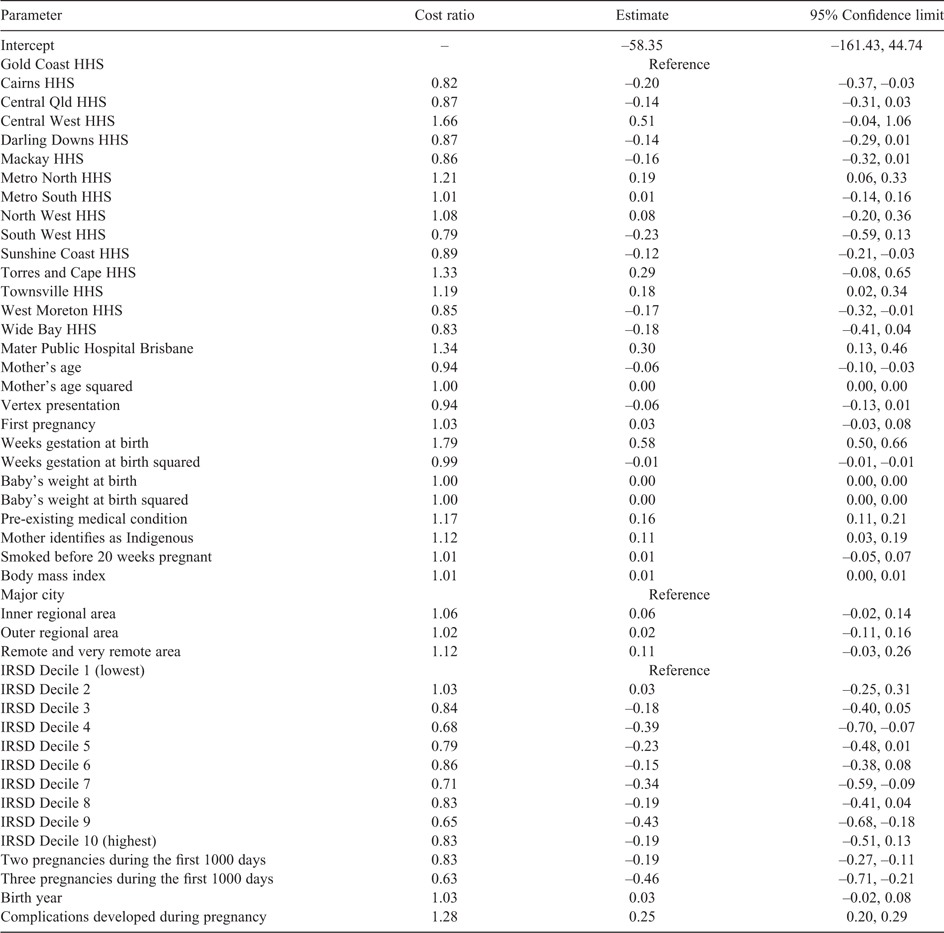
|


